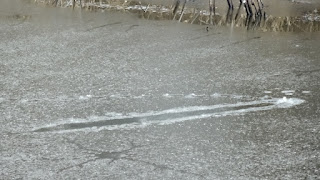6/10/2023
floating log
4/29/2023
muskrat, greener pastures
2/09/2023
tracks surrounding
Last winter, the critters chewed on the tree bark. A little wire fence protected the Tamarack tree this season.
I see proof of success by the tracks surrounding the fence!
Sorry for so many photos of WHITE . . . we have gotten a lot of snow!
11/19/2022
muskrat home
This year, I noticed an area of collapsed dirt over their burrow. Recently, it seemed they were active on the north shore of the pond, digging a new burrow where they may spend the winter.
Some muskrats build domed houses of mud and vegetation visible above ground, but just as often they dig burrows with an underwater entrance.
6/19/2022
4/04/2022
muskrat whiskers

2/26/2022
hare
The pond has been
under a comforter of white snow. The snow layer insulates and protects the
critters tucked in among the rocks, mud, and dormant plants below water and
ice.
On a sunny day, we saw a large rabbit sitting in the snow near the pond. It created a depression in the snow among reeds and wildflower stems, and snuggled down there all day. At dusk, it was gone from that spot. The next day the sunshine was bright on the white snow. The rabbit was in the same spot again, and napped all day. I suspect it was a White-tailed Jackrabbit Lepus townsendii, actually a hare. Jackrabbits are nocturnal hunters and are known to take daylight naps in a shallow hole.
11/22/2020
tracks, cracks, marks, mysteries
10/28/2020
water sports
Sunny and warmer, closer to normal weather today, after an early snow in October. Several Mallards are getting ready for their travel south by feeding on the dwindling supply of plant material in the pond. But the resident muskrats do not like to share their food supply. We watched several encounters today between the animals.
9/27/2020
muskrat tail
The muskrats who live here were gathering breakfast this morning in the pond. One, with tail held high, munched aquatic plants growing to just below the water surface. Their tails are 7 to 11 inches long, covered in scales rather than fur, and flattened vertically (side-to-side) to serve as a rudder in swimming.
8/05/2020
Eastern Forktail damselfly
7/20/2020
muskrat mid-summer meals

 Now that the clover growing near the pond is on the wane, the muskrats are finding other plants to eat.
Now that the clover growing near the pond is on the wane, the muskrats are finding other plants to eat.Here, the muskrats eat pondweed, rushes, grasses, sedges, and other aquatic vegetation. We do not often see them feeding right where they find food. They usually cut and drag plants to a feeding spot near one of their travel paths. There, they can eat without worrying about predators.
Muskrats consume about one-third of their weight each day. That's a lot of greens!
5/15/2020
muskrat take-in dinner
4/16/2020
muskrat tail
The muskrats are nocturnal; we usually see them around the pond later in the day.
Muskrats use their tails as rudders to steer themselves in the water and for a little extra propulsion.
Their tails have scales instead of fur. A muskrat tail is long, thin, and roundish, flattened side to side.
Muskrats use their tails as rudders to steer themselves in the water and for a little extra propulsion.
3/14/2020
muskrat on the pond
Muskrat (Ondatra zibethicus) lives in marshes, ponds, and other wet areas. At first, we thought this might be a beaver, but it is only 14 inches long and a rounded 'rat' tail. Muskrats eat roots and stems of wetland plants plus snails, crayfish, fish, frogs.
12/28/2017
feeder garden bandits
9/18/2015
snag tree
 |
| A pile of peelings from Bitternut Hickory nuts. |
 |
| Peeled nuts stashed in a hole of the snag. |
8/01/2015
7/14/2014
wild berries
1/07/2014
critters at the woods' edge

This Eastern Cottontail rabbit (Sylvilagus floridanus) has a thick fur coat in cold weather, but does not turn white like the native hares do. This may be the rabbit that saunters around the fenced veggie garden all spring, looking for new lettuce to enjoy. They live in the brush pile at the edge of the woods, and like to munch on corn and other seeds that blow out of the tray feeders on windy days. There seemed to be some accumulated in the sheltered depths of the toad haven, half buried by snow.























